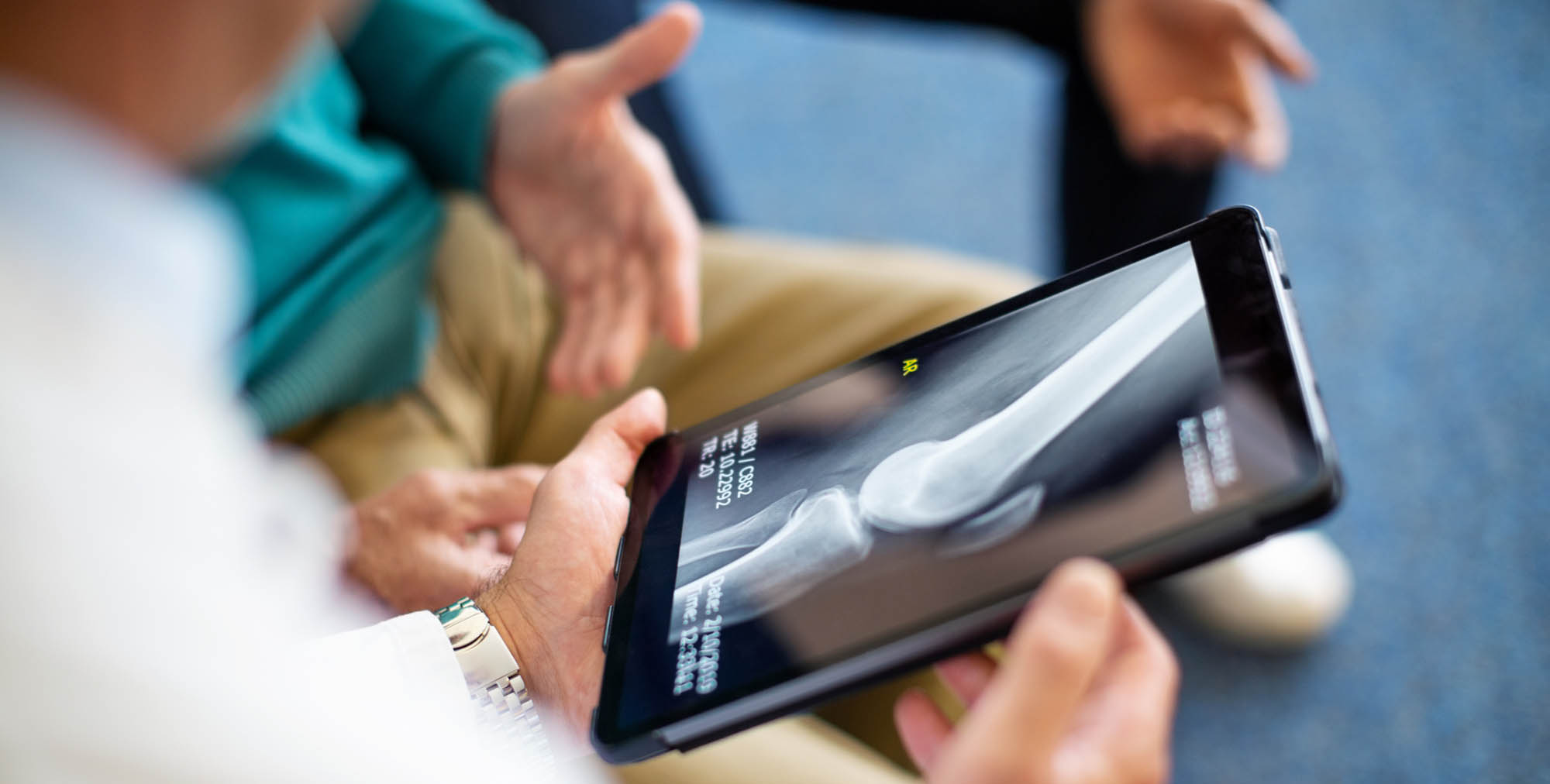Low-Dose Radiation Therapy: An Innovative Treatment for Osteoarthritis
March 13, 2025
Categories: Orthopaedics
Tags: osteoarthritis
 By Matthew Harkenrider, MD, Radiation Oncology
By Matthew Harkenrider, MD, Radiation Oncology
Osteoarthritis is a painful condition that affects 32 million Americans a year. Osteoarthritis occurs when a joint wears down, resulting in pain and less movement.
For most patients, osteoarthritis is first treated with over the counter and prescription medications, physical therapy, and/or joint injections. A joint replacement surgery may be offered when those options no longer provide suitable pain relief. However, low-dose radiation therapy may be a great option for people who want to avoid surgery, cannot safely undergo surgery, or whose osteoarthritis is not severe enough yet for surgery.
What is low-dose radiation therapy?
Low-dose radiation therapy (LDRT) is a painless x-ray treatment that targets the inflammatory cells of the affected joint. LDRT decreases pain signals within the joint, resulting less pain and improved joint function. Research has shown that about 70% of osteoarthritis patients experience some level of pain reduction and/or improved joint function with LDRT.
"Low-dose radiation therapy has been used for more than 100 years to treat osteoarthritis. We brought back LDRT as a non-invasive treatment option, and we have been so pleased to see patients get back to doing the activities that bring them joy with less pain," says Matthew Harkenrider, MD, a radiation oncologist at Loyola Medicine.
This therapy does not change the joint structure itself, but instead it helps relieve the inflammation that contributes to pain.
Benefits of low-dose radiation therapy for osteoarthritis treatment
Low-dose radiation therapy is a promising treatment for osteoarthritis. It offers several advantages over traditional approaches, including:
- Minimal side effects: Side effects from LDRT are rare. Patients may experience slight skin irritation or temporary mild fatigue. There are no documented long-term side effects.
- Non-Invasive alternative: This therapy is a painless and non-invasive procedure. There is no need for hospitalization or anesthesia with LDRT. This makes LDRT a viable option for individuals who are not ready or cannot safely undergo surgery. It also does not prevent patients from getting surgery or joint injections in the future.
- Improved mobility and functionality: Reduced pain allows for increased movement. After LDRT, patients have been able to increase their physical activities including walking, climbing stairs, gardening, and golfing with less pain. Over time, better mobility can lead to a better overall quality of life and decreased use of pain medications.
- Pain relief: Clinical studies demonstrate that LDRT can significantly reduce pain levels by targeting inflammatory processes within the joint. The therapy decreases the production of inflammatory cytokines – small proteins that tell cells to communicate with each other – which are responsible for joint inflammation and discomfort. Many patients report noticeable improvements in pain levels within weeks of completing their treatment regimen.
- Cost-effective treatment: Compared to ongoing costs associated with medications and physical therapy, LDRT can provide long-term relief with fewer financial burdens.
"For many osteoarthritis patients, low-dose radiation therapy offers a safe, effective, and well-tolerated treatment that improves mobility and enhances overall quality of life," says Dr. Harkenrider.
Life-changing improvements for osteoarthritis patients
Many people experience life-changing improvements after undergoing LDRT for osteoarthritis. LDRT has enabled many of Dr. Harkenrider's patients to regain their quality of life.
Golfer finds his form again
An avid golfer suffering from osteoarthritis in his thumbs, he struggled with everyday tasks such as opening jars and holding a golf club. After completing treatment five months ago, he has regained his mobility and is back on the golf course. Encouraged by his results, he is planning additional treatment for wrist pain.
Gardener returns to her hobby
A passionate gardener who relied on a cane and walker due to severe knee pain, she completed treatment almost a year ago. Since then, she has returned to her beloved hobby and had a garden for the first time in several years. She can now climb stairs more comfortably, significantly enhancing her quality of life.
Great-grandmother finds new strength
A 90 year old woman with severe osteoarthritis in both shoulders was unable to hold her great-grandchild. After completing her first course of treatment, she has noticed substantial pain relief and is considering a second round of therapy. Due to her age and underlying health conditions, surgery was not in her goals of care, making low dose radiation therapy a critical solution for improving her daily living.
Who is a good candidate for low-dose radiation therapy?
Low-dose radiation therapy is not suitable for everyone. However, it can be highly beneficial for individuals over the age of 40 who meet specific criteria.
LDRT is most effective for patients who have not responded well to conservative treatments such as nonsteroidal anti-inflammatory drugs, corticosteroid injections, and/or physical therapy. It is particularly beneficial for individuals experiencing chronic pain and inflammation despite these interventions.
For those who are not ideal candidates for joint replacement surgery due to medical conditions such as heart disease, diabetes, or obesity, this offers an alternative path to pain relief without the risks associated with surgical procedures. Aging individuals may also be concerned about surgery or medication side effects but can tolerate low-dose radiation therapy.
It’s important for candidates to understand that this therapy is not a cure for osteoarthritis but rather a treatment to alleviate symptoms and improve quality of life. LDRT does not prevent patients from undergoing joint replacement surgery in the future. Due to the low dose, subsequent surgery remains safe. Patients should discuss their goals and treatment expectations with their health care provider.
"This therapy is particularly beneficial for individuals who have exhausted conventional treatments and are looking for a non-invasive option to manage their osteoarthritis pain and maintain daily activities," says Dr. Harkenrider.
What to expect during low-dose radiation therapy for osteoarthritis
The low-dose radiation therapy process is designed to be simple and stress-free for patients. A typical course of treatment involves:
1. Initial consultation and planning
The process begins with an initial consultation. There, a radiation oncology provider will assess the severity of the patient’s osteoarthritis and determine whether low-dose radiation therapy is an appropriate treatment option. Imaging tests, such as x-rays, may be performed to evaluate the osteoarthritis.
Once approval for treatment is received, the patient will come into Radiation Oncology for a treatment planning session. The health care team will work with the patient to schedule six treatments over two weeks.
2. During the treatment sessions
Each outpatient session lasts approximately 15 to 30 minutes. The patient will be positioned comfortably while the joint is targeted with the focused, painless radiation therapy.
3. Post-treatment care and monitoring
During and after treatment, patients maintain normal daily activities without downtime. Some individuals may experience gradual pain relief within a few weeks, while others may notice improvements over several months. A follow-up appointment with the radiation oncology provider will help track progress and determine if additional radiation treatments are desired to further improve symptoms.
When should surgery be considered for osteoarthritis treatment?
While low-dose radiation therapy can reduce pain in the long-term, it is not a replacement for surgery. LDRT is designed to complement other treatments, such as medications, physical therapy, and joint injections. If a patient is not ready for joint replacement surgery, low-dose radiation therapy can be a bridge between treatment options that may include surgery down the road. If pain is not adequately controlled after LDRT and other osteoarthritis treatments, surgery should be considered.
Dr. Matthew Harkenrider is a board-certified radiation oncologist at Loyola Medicine, specializing in the treatment of gynecologic, thoracic, and genitourinary cancers with a strong interest in the treatment of benign conditions like osteoarthritis. With a strong commitment to patient-centered care, he utilizes advanced radiation therapy techniques to provide personalized treatment plans that optimize outcomes and quality of life. Dr. Harkenrider is actively involved in research, service, and education, contributing to advancements in radiation oncology and mentoring future medical professionals
Book an appointment today to see Dr. Harkenrider self-scheduling an in-person or virtual appointment using myLoyola.
